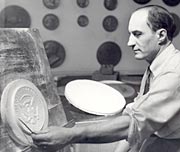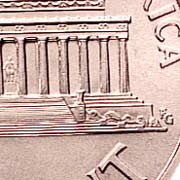|
Remembering a Master Engraver
Frank Gasparro's Legacy Circulating Worldwide
 Listen to Linda Wertheimer's interview with Christina Hansen, daughter of Frank Gasparro, about her father's work. Listen to Linda Wertheimer's interview with Christina Hansen, daughter of Frank Gasparro, about her father's work.
Oct. 3, 2001 -- Frank Gasparro may be the most famous artist you're never heard of. In fact, more than 100 billion copies of his rendition of the Lincoln Memorial are distributed all over the globe -- and chances are, you've got a copy of his work on your person right now.

|
|
In an undated photo, Frank Gasparro in his studio designing the Kenndy half-dollar.
Photo: U.S. Mint
|
Gasparro was an engraver at the U.S. Mint and his Lincoln Memorial design graces the “tails” side of the Lincoln penny. He died Saturday in Havertown, Pa., at the age of 92. All Things Considered co-host Linda Wertheimer recently spoke with Gasparro's daughter Christina Hansen about her father's work and widespread legacy.
Gasparro started as a junior engraver with America’s coin-making agency in 1942 and rose to become the Mint’s lead engraver, a post held for 16 years.
Besides the Lincoln side of the penny, Gasparro designed both sides of the Dwight Eisenhower and Susan B. Anthony dollar coins, and the tails side of the Kennedy half-dollar. He engraved medals for the nation's bicentennial and five presidents -- and even coins used by other countries, but produced by the U.S. Mint.
But Gasparro, who once dreamed of being a sculptor, was particularly proud of the penny, his daughter recalled. His biggest success at the mint came when his design was selected in 1959 to replace the "wheat ears" design that previously graced the back of the Lincoln portrait.

|
|
A close-up of the "tails" side of the penny. Gasparro's initials are on the lower right, and Lincoln's statue can be seen within the memorial building.
Photo: U.S. Mint
|
His biggest flop may have been the Susan B. Anthony dollar coin, even though he was praised for his sensitive portrait of the woman best known for her fight for women's suffrage. Because of its size and weight, the dollar coin was often mistaken for a quarter and is seldom used.
There are two points of trivia that coin collectors love to tell about the penny: There's a small image of Abraham Lincoln between two of the columns on the tail side -- making the penny the only U.S. coin in circulation that bears the likeness of the same person on both sides. Gasparro made changes to his original design, but refused to remove the bust, or his initials. There's a tiny "FG" on the lower right side of the image of the memorial.
Other facts about the penny:
• The likeness of Abraham Lincoln on the penny is an adaptation of a plaque created by Victor David Brenner. President Theodore Roosevelt was so impressed with Brenner's plaque that he recommended to the Secretary of the Treasury that this design be used for a coin. The Lincoln penny was first minted and circulated in 1909.
• Lincoln faces to the right, while all other portraits on coins face to the left. This was not done on purpose -- it was simply the choice of the coin designer.
• The penny is just 2.5 percent copper, with the rest made up of zinc. Each new penny weighs 2.5 grams.
• The penny was first made of pure copper, but in 1837 the mint added zinc and tin to the mix to make the penny bronze. In 1943, because of wartime shortages of copper, the penny was made from zinc-coated steel. In 1982, zinc became the main ingredient in pennies.
• Pennies were the very first coins minted in the United States. In March 1793, the mint distributed 11,178 copper cents.
Source: U.S. Mint
Other Resources
• U.S. Mint
|